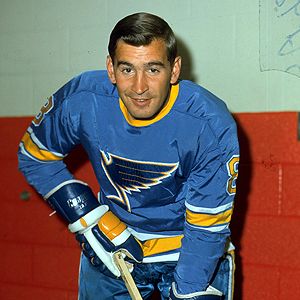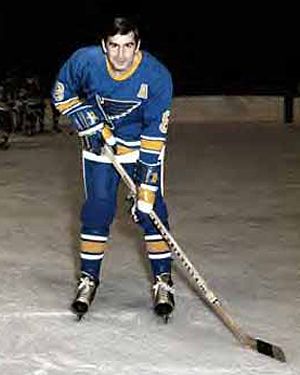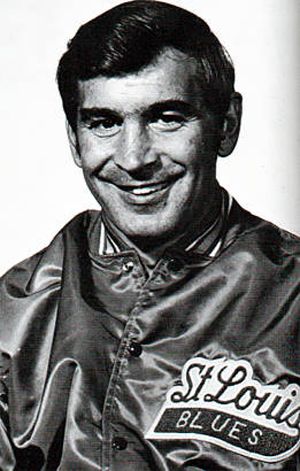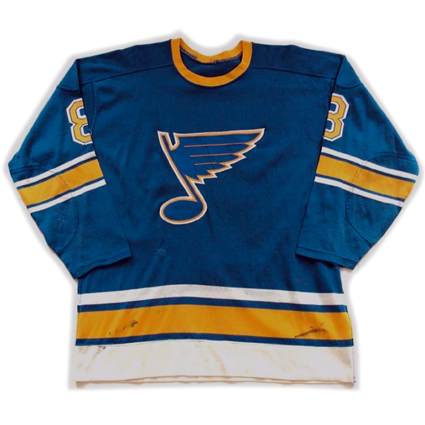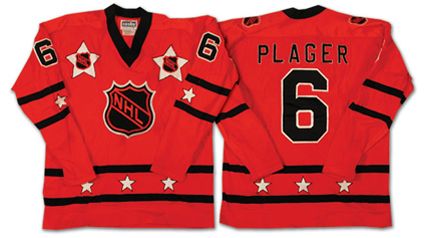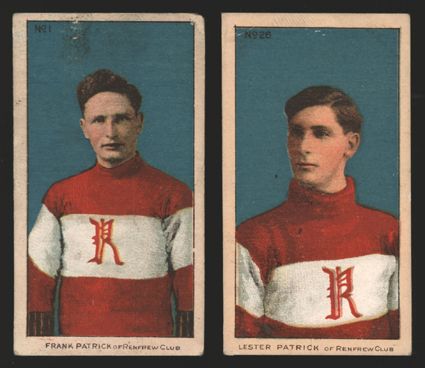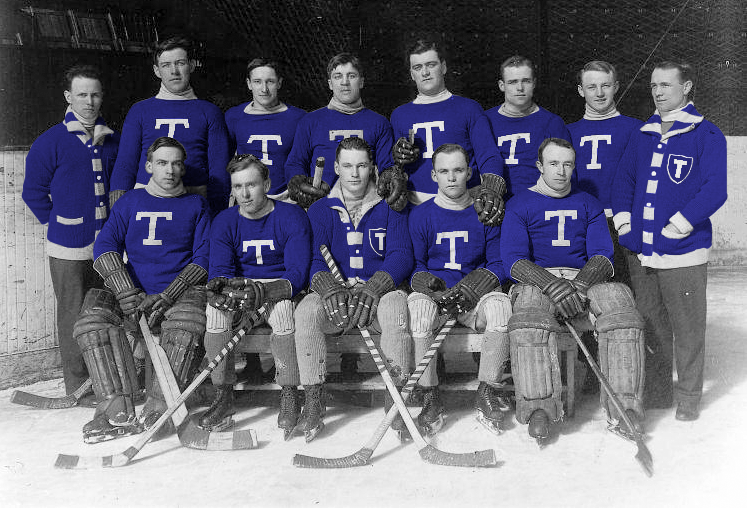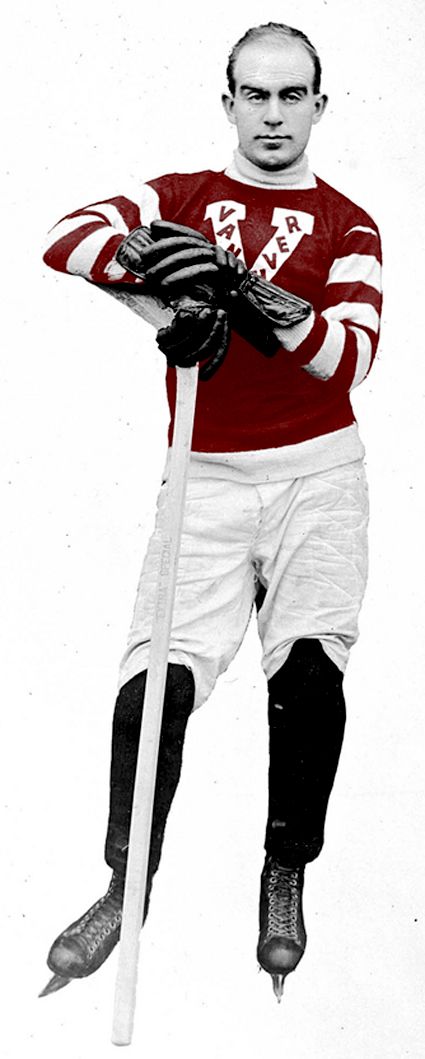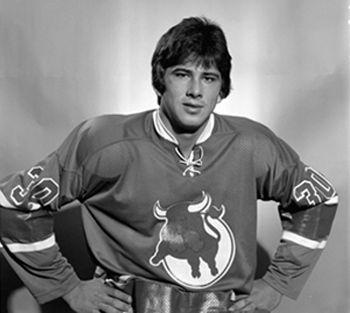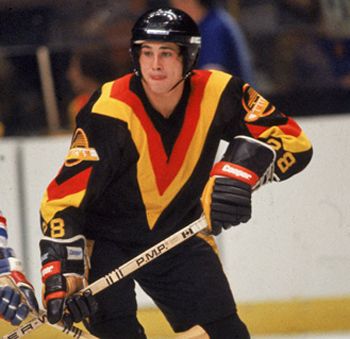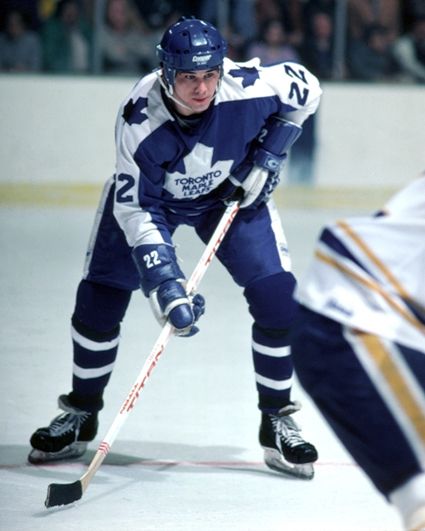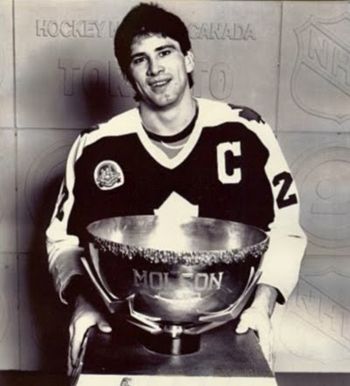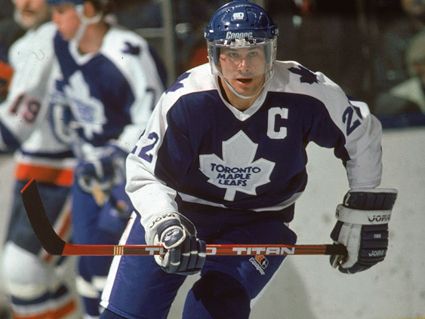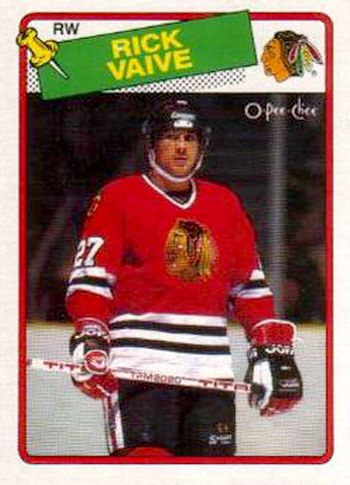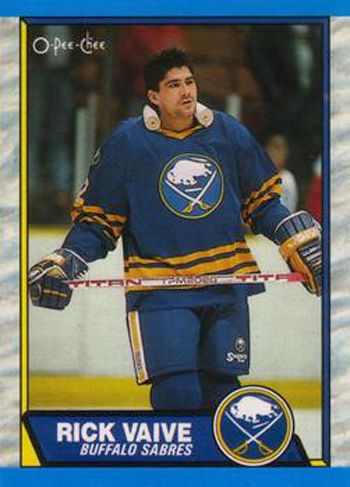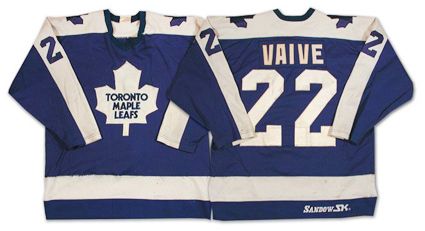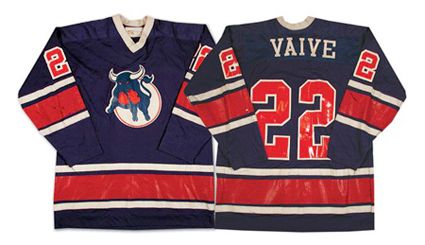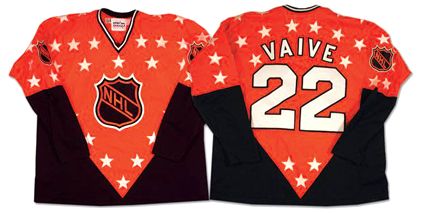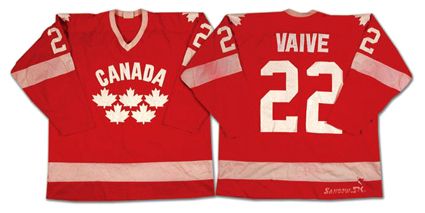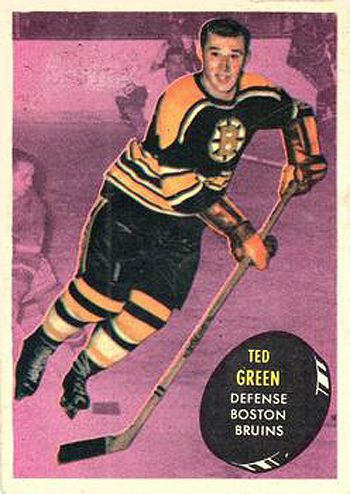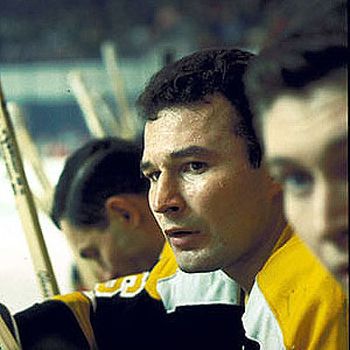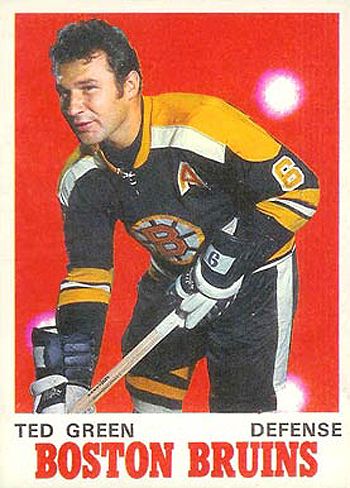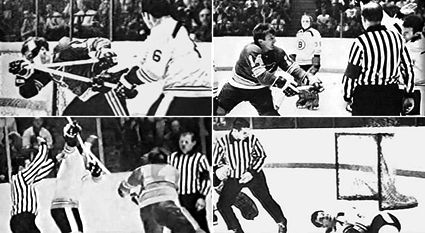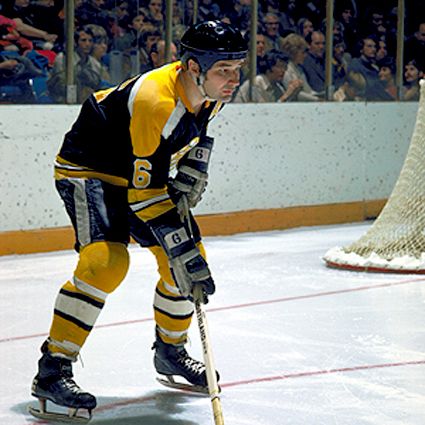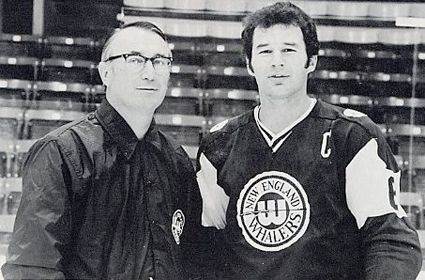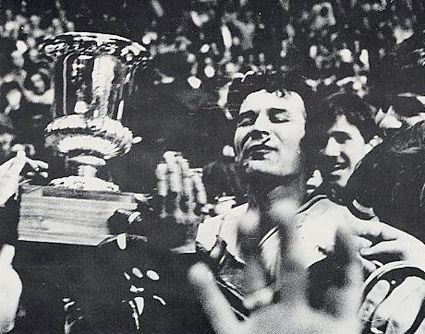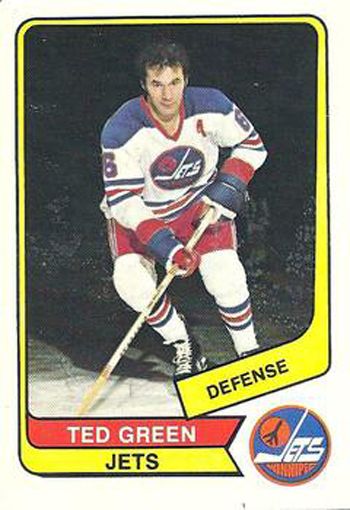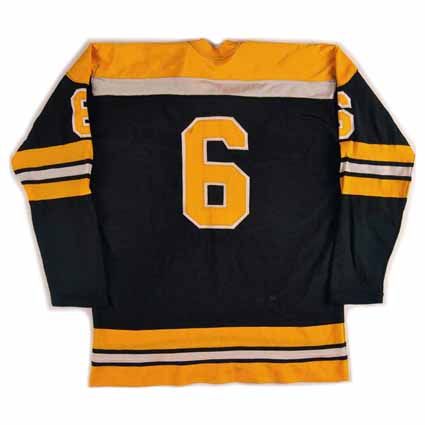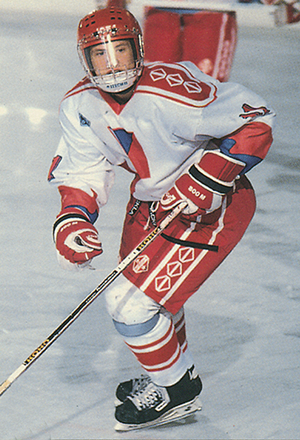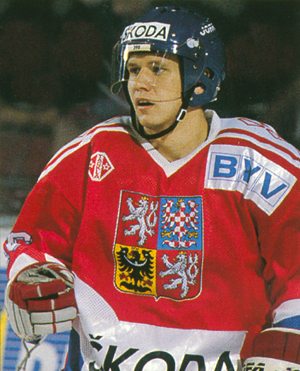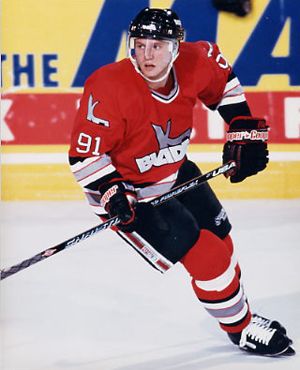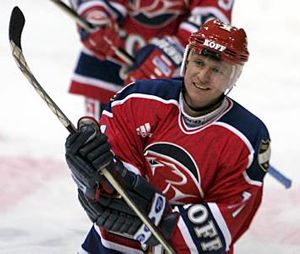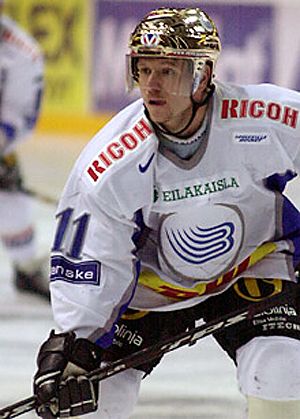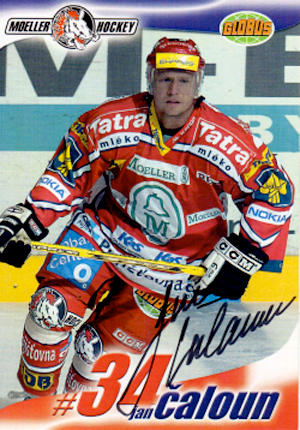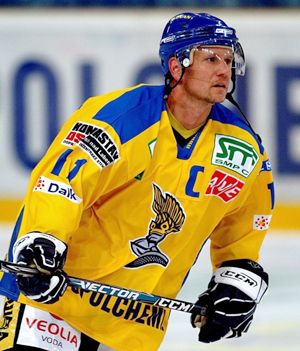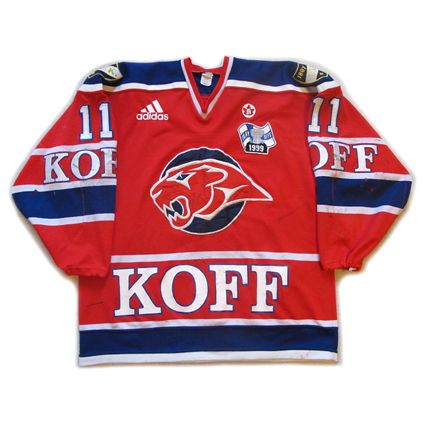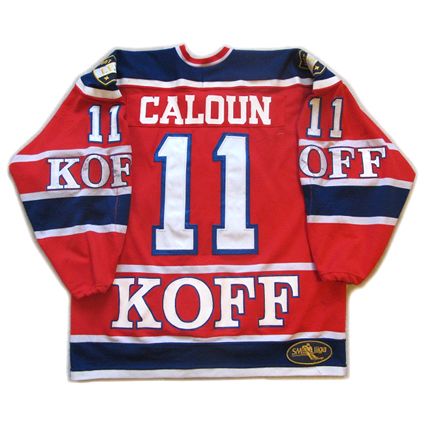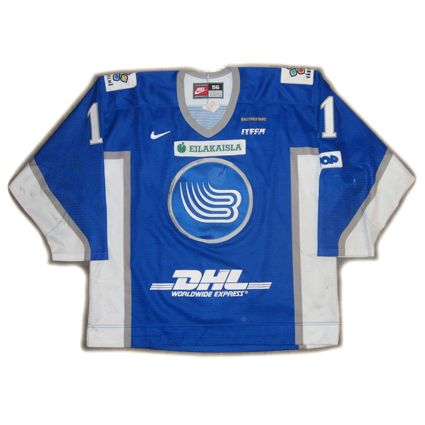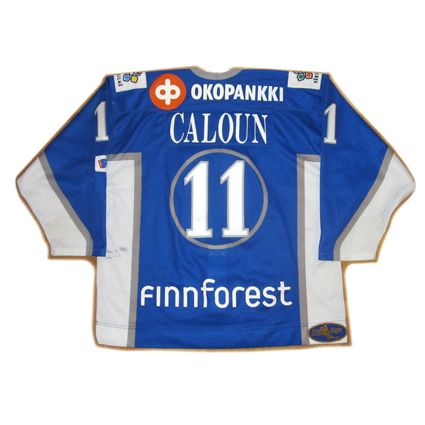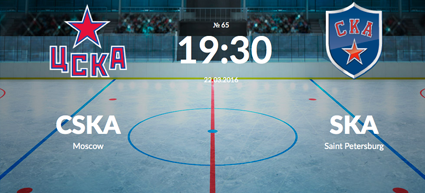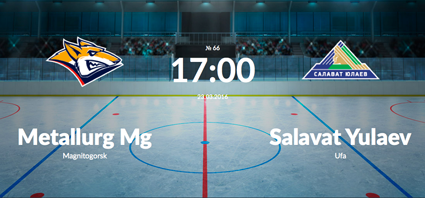Today's video selection features the Plager brothers, Barclay, Bob and Bill.
Saturday, March 26, 2016
1968-69 St. Louis Blues Barclay Plager Jersey
One of the most popular players in St. Louis Blues history, Barclay Plager was born on this date in 1941. Barclay was the oldest of the three Plager brother to play in the NHL, followed by Bill and Bob.
Today's video selection features the Plager brothers, Barclay, Bob and Bill.
Barclay began his road to the NHL playing for the Peterborough Petes on the Ontario Hockey Association in 1957-58. During his four seasons playing for the Petes, Barclay established a himself as a rugged, tough defenseman, a reputation only enhanced by a fight he had with his brother Bob, who was playing for the Guelph Royals.
Barclay, accidentally he claimed, jammed his stick in Bob's mouth and Bob responded with his fists. "We went at it pretty good on the ice," Bob remembers, "but they broke it up. As we went into the penalty box he gave me a shove and we started fighting again. Then, after we were thrown out of the game, we continued to battle in the runway leading to the dressing rooms. But I got the best of him for the first time. Afterwards I met him in a restaurant across the street from the rink. I was sitting there eating when he walked in. We looked at each other and I didn't know what was going to happen. The whole Guelph team rushed into the place to see. Everyone figured we'd go at it again, but Barclay just looked me in the eye and said, 'Can you lend me five dollars?'"
Like many players of his era, Plager found himself mired in the minor leagues, unable to crack the exclusive ranks of the NHL, which was then only six member clubs which afforded approximately 30 jobs to defensemen league wide.
Plager began his travels through the minor leagues with a stop in Hull in 1961-62, Edmonton and Pittsburgh in 1962-63, Omaha in 1963-64, where he had an outstanding season with 75 points where he led the league in both assists and penalty minutes by wide margins as Omaha captured the CPHL's inaugural Adams Cup, and Springfield in 1964-65 and 1965-66 before splitting time between Springfield and Omaha in 1966-67.
Just when it looked as if Plager would toil in the minors for the remainder of his playing days, the NHL expansion of 1967-68 doubled the size of the league overnight, creating twice as many job opportunities than previously available.
With his rights acquired by the St. Louis Blues from the New York Rangers, Plager embarked on a new phase of his career in the NHL. While the Blues finished third in the "Western" division, comprised of the six new expansion clubs, they outlasted both the Philadelphia Flyers and Minnesota North Stars to qualify for the Stanley Cup Finals in only their first season in the NHL. Although Plager only played in 49 of the Blues games due to spending 20 games with the Buffalo Bisons of the AHL, Plager's no nonsense approach to his game led to a league leading 153 penalty minutes. Barclay was also joined on the Blues blueline by his brother Bob who arrived via a trade with the Rangers.
In 1968-69, backed by veteran goaltenders Glenn Hall and Jacques Plante, Plager and the Blues defensive corps of Al Arbour, Jean-Guy Talbot, veteran Doug Harvey, Noel Picard, Jim Roberts, Bob Plager, Terry Crisp and Ron Schock shockingly allowed the least goals against by a country mile, 39 less than the New York Rangers and 68 less an any of their expansion cousins to win the Vezina Trophy for Hall and Plante.
"We did anything to protect the goaltender," recalled Bob Plager. "The greatest time for us was the year we won the Vezina Trophy. Glenn Hall and Jacques Plante were in goal and we only allowed 157 goals. That record will probably never be broken. Winning the Vezina was the finest reward anyone could get."
Of note, Bill Plager arrived in St. Louis for a pair of games, giving St. Louis all three brothers at the same time.
Barclay, Bill and Bob Plager lacing up their skates for the Blues
The Blues again returned to the Stanley Cup Finals after eliminating the Flyers and Los Angeles Kings.
The Blues were again stingy on defense, coming in second to Boston but 46 goals better than any other "Second 6" franchise and again made their annual trip to the finals, but once again they were swept by an Original 6 franchise. Barclay led the Blues in trips to the penalty box that season, besting his brother Bob 128 penalty minutes to 113.
Barclay, Bob and Bill would play for the Blues during parts of three seasons, with the limiting factor being mainly Bill's number of games played, as he had 2 in 1968-69, 24 in 1969-70 and 36 during his final season with the Blues in 1970-71 before moving on to the Atlanta Flames and considerably more playing time.
For the next six seasons, Barclay would continue to provide his rock-steady defensive play and offensive output, as he would play no less than 54 games while scoring between 26 and 33 points, which was Plager's NHL career high. Additionally, he was named team captain in 1972, a position he would hold until 1976.
After one more season in St. Louis, Barclay would play just two final games for the Blues before being named as a player/coach for the Kansas City Blues in 19767-77. He remained an effective player and as well as a team leader, as coach Plager guided his team to the CHL finals, while Plager the player was named as the league's MVP.
He served the same dual roles in 1977-78 with the Salt Lake Golden Eagles, which would prove to be his final season as an active player.
He remained with the Blues organization as a scout and an assistant coach before being named the club's head coach for the 1978-79 season.
His number 8 was retired by the Blues on March 24, 1981.
Plager's final NHL stats were 44 goals and 187 assists for 231 points along with 1,115 penalty minutes, which included leading the team on four separate occasions, and 15 broken noses, a testament to his bruising, shot blocking ways which earned him the hearts of the fans.
Today's featured jersey is a 1968-69 St. Louis Blues Barclay Plager jersey as worn by the Blues during their second ever season, one in which they would make it all the way to the Stanley Cup Finals.
This jersey style, introduced during the Blues first season of 1967-68, would remain in use through 1972-73 when the colors of the striping were reversed, with names arriving on the back in 1977-78. That similar style would survive through the 1978-79 season when additional trim was added to the shoulder yoke, keeping it in line with the striping on the shoulders of the white jerseys.
Bonus Jersey: Today's bonus jersey is a 1973 NHL All-Star Game Barclay Plager jersey. Plager played in the NHL All-Star Game on four occasions, 1970, 1971, 1973 and 1974. This particular jersey was worn by Barclay Plager during the 1973 edition held in New York's Madison Square Garden.
This was the first year for this brand new style of All-Star jersey and it would be worn for eight All-Star Games through 1981, skipping 1979 when a slightly different jersey was worn for the Challenge Cup against the Soviet Union instead of the normal all-star game format.
photo courtesy of Classic Auctions
Today's video selection features the Plager brothers, Barclay, Bob and Bill.
Labels:
Plager Barclay,
St. Louis Blues
Friday, March 25, 2016
The Rover Position - 1914-15 Vancouver Millionaires Fred "Cyclone" Taylor Jersey
From the earliest days of ice hockey in the late nineteenth century, a hockey team consisted of not six, but seven players. The Goaltender, two Defensemen, three Forwards and the Rover, who did not have a set position on the ice and was free to roam at will.
As the game evolved and the players skills improved, the need for the extra player fell out of favor as a way to make more room on the ice and speed up the game.
Shortly after it was formed in 1910, the direct predecessor to the National Hockey League, the National Hockey Association (NHA), decided to drop the Rover position and reduce the number of players on the ice to today's familiar six - five skaters and a goaltender.
Meanwhile, out west, the Pacific Coast Hockey Association, led by Frank and Lester Patrick chose to keep the Rover as a part of their lineup. While the Patrick's were innovators, introducing many new concepts to the game, such as blue lines, goal creases, forward passing, player numbers, penalty shots, playoffs and allowing goalies to leave their feet, they did cling to the Rover position.
This resulted in a compromise, as the Stanley Cup was still a challenge cup at the time of the formation of the NHA. The first time the NHA champions were challenged by the representative of he PCHA was in March of 1914 in a best of five series when the Toronto Hockey Club defended their rights to the cup against Lester Patrick's Victoria Aristocrats. Game 1 of the series was played under NHA six man rules and was won by Toronto 5-2.
Game 2 was conducted under PCHA rules of seven man hockey, which also meant utilizing the blue lines to divide the ice into three zones. It was a much closer game that eventually went to overtime tied at 5-5 before Toronto prevailed when Rover Roy McGiffin scored after 18 minutes of overtime.
Again playing under NHA rules, Toronto prevailed in a much tighter contest in Game 3 by a final score of 2-1 to win not only the game, but the best of five series 3 games to none.
At this point in the development of the game, the two leagues were the top two professional leagues in Canada and the Stanley Cup evolved from a challenge cup to a format where the winner of the NHA faced off against the champion of the PCHA every year for the cup in a best of five series, which alternated each year between the eastern NHA and the western PCHA as the host. Additionally, every other game would alternate between six man NHA and seven man PCHA rules.
In 1915 the Vancouver Millionaires defeated the Ottawa Senators 3-0 to become the first PCHA champion, striking a blow for the continued use of the Rover. 1916 saw the cup return to the east when the Montreal Canadiens won the first of 24 cups in franchise history when they defeated the Portland Rosebuds 3-2. The cup returned to the west in 1917 when the Seattle Metropolitans became the first team from the United States to win the rights to the cup when the defeated the Canadiens 3-1.
In 1918 the Toronto Arenas of the newly formed National Hockey League, who would eventually evolve into today's Toronto Maple Leafs, took the cup back for the NHA with a 3-2 series win over the Millionaires.
The 1919 finals in Seattle were called off after Game 5 with each team having won twice with one tie due to an outbreak of influenza when most of the Canadiens players fell ill and were hospitalized, with "Bad" Joe Hall of Montreal dying four days later.
The first Olympic ice hockey tournament in 1920 saw teams play seven man hockey with the Rover position used for the only time in Olympic play.
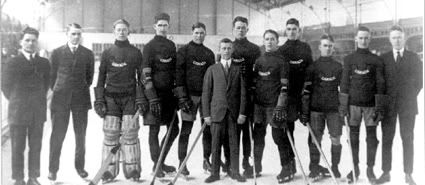
The first Olympic hockey champions, the Winnipeg Falcons representing
Canada played seven man hockey with a Rover in 1920
The Senators regained the cup for the first time since 1911 when they outlasted the Metropolitans 3-2 in 1920, taking advantage of the familiar NHL six man rules to win "at home" in Game 5, which was played in Toronto due to unfavorable ice conditions in Ottawa.
Ottawa retained the cup in 1921 in a series played in Vancouver that went the full five games as the Senators took the decisive Game 5 played under seven man PCHA rules.
The 1922 series took place in Toronto between the Millionaires and the NHL's Toronto St. Pats, who were an evolution of the 1918 champion Toronto Arenas. Vancouver took Game 1 by a score of 4-3 under six man rules. Game 2 was a 2-1 overtime win for the St. Pats playing under the PCHA's Rover rule book. Again under the NHL's six man format, the PCHA's Millionaires shut out Toronto by a score of 3-0 to to take a 2-1 series lead and put Toronto on the brink of elimination.
On this date in 1922, the St. Pats dominated the Millionaires by a score of 6-0 as John Ross Roach became the first rookie to record a shutout in Stanley Cup play in the final game for the Rover position.
Three days later, Babe Dye would lead the St. Pats comeback from their 2-1 series deficit by scoring 4 of Toronto's 5 goals in their 5-1 win to take the series 3 games to 2 to close out the Rover era once and for all.
For the 1922-23 season, the PCHA would finally drop the Rover and adopt the six man hockey of the NHL 11 years after the NHA made the switch in order to free up space on the ice and increase the speed of play.
The Hockey Hall of Fame includes 19 players who played the Rover position and they are among some of the finest players to have ever played the game - and not just from the game's early days, as the Rover was charged with not only joining the offensive attack, but hurrying back up the ice to help out on defense, a heavy demand which required speed and endurance in the days before substitutions or the though of on the fly line changes.
Among those 19 Rovers in The Hall are hockey legends such as Hobey Baker, Tommy Dunderdale, Si Griffis, Newsy Lalonde, Frank McGee, Lester Patrick, Dider Pitre, Bruce Stuart, Harry Westwick and the great Cyclone Taylor.
Today's featured jersey is a 1914-15 Vancouver Millionaires Fred "Cyclone" Taylor jersey. From the time of their inception in1911, the Millionaires used maroon jerseys adorned with a large, white V of varying styles, most of which had the name "Vancouver" contained inside.
Taylor was one of the early greats of hockey, playing for the Portage Lakes team in the first professional league back in 1905-06. He subsequently played for the Ottawa Senators and the Renfrew Creamery Kings before being lured west by his former Renfrew teammates, the Patrick brothers, for their Pacific Coast Hockey League's Vancouver Millionaires in 1912, with whom he would play for the rest of his career, spending ten seasons with the club. His scoring exploits were the stuff of legend, as he scored 159 goals and 263 points in 130 games.
He was inducted into the Hockey Hall of Fame in 1947 as well as the Canadian Sports Hall of Fame, the British Columbia Sports Hall of Fame and the International Hockey Hall of Fame and was chosen to drop the puck for the ceremonial faceoff at the first ever Vancouver Canucks game in 1970.
Today's video section is a look at hockey's first superstar, Cyclone Taylor.
The Stanley Cup Champion 1905 Ottawa Silver Seven,
complete with Rover Frank McGee, back row right
As the game evolved and the players skills improved, the need for the extra player fell out of favor as a way to make more room on the ice and speed up the game.
Shortly after it was formed in 1910, the direct predecessor to the National Hockey League, the National Hockey Association (NHA), decided to drop the Rover position and reduce the number of players on the ice to today's familiar six - five skaters and a goaltender.
Meanwhile, out west, the Pacific Coast Hockey Association, led by Frank and Lester Patrick chose to keep the Rover as a part of their lineup. While the Patrick's were innovators, introducing many new concepts to the game, such as blue lines, goal creases, forward passing, player numbers, penalty shots, playoffs and allowing goalies to leave their feet, they did cling to the Rover position.
This resulted in a compromise, as the Stanley Cup was still a challenge cup at the time of the formation of the NHA. The first time the NHA champions were challenged by the representative of he PCHA was in March of 1914 in a best of five series when the Toronto Hockey Club defended their rights to the cup against Lester Patrick's Victoria Aristocrats. Game 1 of the series was played under NHA six man rules and was won by Toronto 5-2.
Game 2 was conducted under PCHA rules of seven man hockey, which also meant utilizing the blue lines to divide the ice into three zones. It was a much closer game that eventually went to overtime tied at 5-5 before Toronto prevailed when Rover Roy McGiffin scored after 18 minutes of overtime.
Again playing under NHA rules, Toronto prevailed in a much tighter contest in Game 3 by a final score of 2-1 to win not only the game, but the best of five series 3 games to none.
The Stanley Cup champion 1914 Toronto Blueshirts, winners
of the first Stanley Cup with shared NHA and PCHA rules
At this point in the development of the game, the two leagues were the top two professional leagues in Canada and the Stanley Cup evolved from a challenge cup to a format where the winner of the NHA faced off against the champion of the PCHA every year for the cup in a best of five series, which alternated each year between the eastern NHA and the western PCHA as the host. Additionally, every other game would alternate between six man NHA and seven man PCHA rules.
In 1915 the Vancouver Millionaires defeated the Ottawa Senators 3-0 to become the first PCHA champion, striking a blow for the continued use of the Rover. 1916 saw the cup return to the east when the Montreal Canadiens won the first of 24 cups in franchise history when they defeated the Portland Rosebuds 3-2. The cup returned to the west in 1917 when the Seattle Metropolitans became the first team from the United States to win the rights to the cup when the defeated the Canadiens 3-1.
the first Stanley Cup winner from the PCHA
In 1918 the Toronto Arenas of the newly formed National Hockey League, who would eventually evolve into today's Toronto Maple Leafs, took the cup back for the NHA with a 3-2 series win over the Millionaires.
The 1919 finals in Seattle were called off after Game 5 with each team having won twice with one tie due to an outbreak of influenza when most of the Canadiens players fell ill and were hospitalized, with "Bad" Joe Hall of Montreal dying four days later.
The first Olympic ice hockey tournament in 1920 saw teams play seven man hockey with the Rover position used for the only time in Olympic play.

The first Olympic hockey champions, the Winnipeg Falcons representing
Canada played seven man hockey with a Rover in 1920
The Senators regained the cup for the first time since 1911 when they outlasted the Metropolitans 3-2 in 1920, taking advantage of the familiar NHL six man rules to win "at home" in Game 5, which was played in Toronto due to unfavorable ice conditions in Ottawa.
Ottawa retained the cup in 1921 in a series played in Vancouver that went the full five games as the Senators took the decisive Game 5 played under seven man PCHA rules.
The 1922 series took place in Toronto between the Millionaires and the NHL's Toronto St. Pats, who were an evolution of the 1918 champion Toronto Arenas. Vancouver took Game 1 by a score of 4-3 under six man rules. Game 2 was a 2-1 overtime win for the St. Pats playing under the PCHA's Rover rule book. Again under the NHL's six man format, the PCHA's Millionaires shut out Toronto by a score of 3-0 to to take a 2-1 series lead and put Toronto on the brink of elimination.
On this date in 1922, the St. Pats dominated the Millionaires by a score of 6-0 as John Ross Roach became the first rookie to record a shutout in Stanley Cup play in the final game for the Rover position.
Three days later, Babe Dye would lead the St. Pats comeback from their 2-1 series deficit by scoring 4 of Toronto's 5 goals in their 5-1 win to take the series 3 games to 2 to close out the Rover era once and for all.
For the 1922-23 season, the PCHA would finally drop the Rover and adopt the six man hockey of the NHL 11 years after the NHA made the switch in order to free up space on the ice and increase the speed of play.
The Hockey Hall of Fame includes 19 players who played the Rover position and they are among some of the finest players to have ever played the game - and not just from the game's early days, as the Rover was charged with not only joining the offensive attack, but hurrying back up the ice to help out on defense, a heavy demand which required speed and endurance in the days before substitutions or the though of on the fly line changes.
Among those 19 Rovers in The Hall are hockey legends such as Hobey Baker, Tommy Dunderdale, Si Griffis, Newsy Lalonde, Frank McGee, Lester Patrick, Dider Pitre, Bruce Stuart, Harry Westwick and the great Cyclone Taylor.
Today's featured jersey is a 1914-15 Vancouver Millionaires Fred "Cyclone" Taylor jersey. From the time of their inception in1911, the Millionaires used maroon jerseys adorned with a large, white V of varying styles, most of which had the name "Vancouver" contained inside.
Taylor was one of the early greats of hockey, playing for the Portage Lakes team in the first professional league back in 1905-06. He subsequently played for the Ottawa Senators and the Renfrew Creamery Kings before being lured west by his former Renfrew teammates, the Patrick brothers, for their Pacific Coast Hockey League's Vancouver Millionaires in 1912, with whom he would play for the rest of his career, spending ten seasons with the club. His scoring exploits were the stuff of legend, as he scored 159 goals and 263 points in 130 games.
He was inducted into the Hockey Hall of Fame in 1947 as well as the Canadian Sports Hall of Fame, the British Columbia Sports Hall of Fame and the International Hockey Hall of Fame and was chosen to drop the puck for the ceremonial faceoff at the first ever Vancouver Canucks game in 1970.
Today's video section is a look at hockey's first superstar, Cyclone Taylor.
Labels:
Rover position
Thursday, March 24, 2016
1981-82 Toronto Maple Leafs Rick Vaive Jersey
Rick Vaive roared onto the scene of junior hockey, scoring 51 goals and 110 points for the Sherbrooke Castors of the QMJHL in the 1976-77 season as a 17 year old. His second season of 1977-78 saw him shift his game into an even higher gear, scoring more than a goal per game with 76 in 68 games. He added 79 assists for a total of 155 points while demonstrating his rugged style of play with 199 penalty minutes. He also made his international debut at the 1978 World Junior Championships for Canada, scoring 3 goals in 6 games as the host Canadians won bronze.
Vaive was then signed as a free agent by the Birmingham Bulls of the World Hockey Association as part of their strategy to sign underage junior players in an effort to acquire them before the NHL rules would allow them to be drafted after they turned 20 in the final, desperate days of the WHA.
Vaive was one of six underage players on the Bulls roster that season, which earned the club the nickname of the "Baby Bulls". The other five to join Vaive were Craig Hartsburg, Rob Ramage and Gaston Gingras on defense, goaltender Pat Riggin and forward Michel Goulet. Vaive not only led the Bulls in scoring that season with 26 goals and 59 points in 75 games, but also led the entire WHA in penalty minutes with 248.
Following the season, Vaive was drafted by the Vancouver Canucks at the 1979 NHL Entry Draft with the fifth overall pick. Vaive was free to play for Vancouver, as the WHA ceased operations after the 1978-79 season. Four of the six remaining teams entered the NHL as expansion clubs, the New England Whalers, Winnipeg Jets, Edmonton Oilers and Quebec Nordiques, while the Cincinnati Stingers and the Bulls folded.
Vaive then joined the Canucks for the 1979-80 season, but his time in Vancouver was short lived, as he played just 47 games before being traded to the Toronto Maple Leafs during his rookie season when he and Bill Derlago were dealt for Tiger Williams and Jerry Butler. Vaive had scored 13 goals and 21 points with the Canucks and then added another 9 goals and 16 points in 22 games for the Maple Leafs, a total of 22 goals his rookie season.
In 1980-81, his point total rose to 33 goals and 62 points before he joined the ranks of the elite on this date in 1982 when he became the first player in Toronto Maple Leafs history to score 50 goals in a season during a 4-3 win over the St. Louis Blues. He eventually finished the season with 54 goals and 89 points to lead Toronto in scoring.
Following the season Vaive made his World Championships debut for Canada where he won a bronze medal with 3 goals and 4 points in 9 games.
He backed that up with 51 goals in 1982-83 and 52 in 1982-83 on his way to a career high 93 points as he led the club in scoring for the second time. He was name the captain of the Maple Leafs in 1982 and would hold that position through 1986. He also began a run of three straight NHL All-Star Game appearances in 1982, 1983 and 1984.
While his goal production dipped to 35, he again was Toronto's leading scorer in 1984-85 with 68 points. He again suited up for Canada following the end of the NHL regular season and contributed 8 points in 10 games on his way to a silver medal.
He would play two more seasons with the Maple Leafs with similar totals (33 g - 64 pts, 32 g - 66 pts) before he was involved in a trade which sent Vaive, Steve Thomas and Bob McGill to the Chicago Blackhawks in exchange for Al Secord and Ed Olczyk.
His first season in Chicago was his best, as he joined Denis Savard (44) and Steve Larmer (41) as 40 goal scorers with Vaive finished second on the team with 43.
He started the 1988-89 season with the Blackhawks, but after 30 games, in December he was traded to the Buffalo Sabres but was limited to just 28 games due to injuries.
Vaive would play two more full seasons with the Sabres, averaging 27 goals and 50 points before one final season of 1991-92 where he played 12 games with the Rochester Americans of the AHL and 20 games with Buffalo in the NHL.
He would play one final season of pro hockey in 1992-93 after being signed by the Vancouver organization, seeing action in 38 games for the Hamilton Canucks of the AHL, where he scored 31 goals in 38 games. He would immediately become a head coach for the South Carolina Stingrays of the ECHL for five seasons following his playing days, which included a championship in 1997 followed by stints in the AHL and OHL.
His final NHL totals were 876 games with 441 goals and 788 points. He would also add 43 points in 54 playoff games during his career.
Today's featured jersey is a 1981-82 Toronto Maple Leafs Rick Vaive jersey as worn the season he became the first Maple Leafs player to score 50 goals in a season on his way to 54.
The Maple Leafs adopted this jersey style for the 1970-71 season with a lace up collar. After two seasons they changed to a v-neck collar for 1972-73 only to return to the lace up collar for two additional seasons. It was back to the v-neck collar in 1975-76.
Names arrived on the back in 1978-79, but not without a fight from Maple Leafs owner Harold Ballard, who thought player names on the back would hurt the sales of programs. The jerseys would then remain the same all the way through the 1991-92 season, a run of 21 years in all.
Bonus jersey: Today's bonus jersey is a 1978-79 Birmingham Bulls Rick Vaive jersey as worn during Vaive's first pro season and the WHA's last. The Bulls wore this jersey style dating back to their days as the Toronto Toros starting in 1973-74.
When the team moved to Birmingham for the 1976-77 season, blue trim was added to the red stripes around the arms and waist, changing them from two colors to three. They wore a lace up collar in 1976-77 and 1977-78 and went with a v-neck collar for their final season of play.
Extra bonus jersey: Today's extra bonus jersey is a 1982 NHL All-Star Game Rick Vaive jersey
as worn during Vaive's first NHL All-Star Game. This would be the only time this overly busy jersey style would be used by the NHL. Not a terrible jersey, but a 75% reduction in the amount of decorative stars would have served this jersey well.
Extra extra bonus jersey: Today's extra extra bonus jersey is a 1982 Canada National Team Rick Vaive jersey
as worn during the 1982 World Championships where Canada earned a bronze medal in Vaive's first international tournament.
Canada first wore this style for the 1980 Olympics and continued to wear it through the 1982 World Championships.
Vaive was then signed as a free agent by the Birmingham Bulls of the World Hockey Association as part of their strategy to sign underage junior players in an effort to acquire them before the NHL rules would allow them to be drafted after they turned 20 in the final, desperate days of the WHA.
Vaive was one of six underage players on the Bulls roster that season, which earned the club the nickname of the "Baby Bulls". The other five to join Vaive were Craig Hartsburg, Rob Ramage and Gaston Gingras on defense, goaltender Pat Riggin and forward Michel Goulet. Vaive not only led the Bulls in scoring that season with 26 goals and 59 points in 75 games, but also led the entire WHA in penalty minutes with 248.
Following the season, Vaive was drafted by the Vancouver Canucks at the 1979 NHL Entry Draft with the fifth overall pick. Vaive was free to play for Vancouver, as the WHA ceased operations after the 1978-79 season. Four of the six remaining teams entered the NHL as expansion clubs, the New England Whalers, Winnipeg Jets, Edmonton Oilers and Quebec Nordiques, while the Cincinnati Stingers and the Bulls folded.
Vaive then joined the Canucks for the 1979-80 season, but his time in Vancouver was short lived, as he played just 47 games before being traded to the Toronto Maple Leafs during his rookie season when he and Bill Derlago were dealt for Tiger Williams and Jerry Butler. Vaive had scored 13 goals and 21 points with the Canucks and then added another 9 goals and 16 points in 22 games for the Maple Leafs, a total of 22 goals his rookie season.
Vaive broke into the NHL with Vancouver
In 1980-81, his point total rose to 33 goals and 62 points before he joined the ranks of the elite on this date in 1982 when he became the first player in Toronto Maple Leafs history to score 50 goals in a season during a 4-3 win over the St. Louis Blues. He eventually finished the season with 54 goals and 89 points to lead Toronto in scoring.
Following the season Vaive made his World Championships debut for Canada where he won a bronze medal with 3 goals and 4 points in 9 games.
He backed that up with 51 goals in 1982-83 and 52 in 1982-83 on his way to a career high 93 points as he led the club in scoring for the second time. He was name the captain of the Maple Leafs in 1982 and would hold that position through 1986. He also began a run of three straight NHL All-Star Game appearances in 1982, 1983 and 1984.
Vaive with the Molson Cup as the Maple Leafs player
with the most 3 Stars of the Game awards in 1983-84
While his goal production dipped to 35, he again was Toronto's leading scorer in 1984-85 with 68 points. He again suited up for Canada following the end of the NHL regular season and contributed 8 points in 10 games on his way to a silver medal.
Vaive was captain of the Maple Leafs for four seasons
He would play two more seasons with the Maple Leafs with similar totals (33 g - 64 pts, 32 g - 66 pts) before he was involved in a trade which sent Vaive, Steve Thomas and Bob McGill to the Chicago Blackhawks in exchange for Al Secord and Ed Olczyk.
His first season in Chicago was his best, as he joined Denis Savard (44) and Steve Larmer (41) as 40 goal scorers with Vaive finished second on the team with 43.
He started the 1988-89 season with the Blackhawks, but after 30 games, in December he was traded to the Buffalo Sabres but was limited to just 28 games due to injuries.
Vaive would play two more full seasons with the Sabres, averaging 27 goals and 50 points before one final season of 1991-92 where he played 12 games with the Rochester Americans of the AHL and 20 games with Buffalo in the NHL.
He would play one final season of pro hockey in 1992-93 after being signed by the Vancouver organization, seeing action in 38 games for the Hamilton Canucks of the AHL, where he scored 31 goals in 38 games. He would immediately become a head coach for the South Carolina Stingrays of the ECHL for five seasons following his playing days, which included a championship in 1997 followed by stints in the AHL and OHL.
His final NHL totals were 876 games with 441 goals and 788 points. He would also add 43 points in 54 playoff games during his career.
Today's featured jersey is a 1981-82 Toronto Maple Leafs Rick Vaive jersey as worn the season he became the first Maple Leafs player to score 50 goals in a season on his way to 54.
The Maple Leafs adopted this jersey style for the 1970-71 season with a lace up collar. After two seasons they changed to a v-neck collar for 1972-73 only to return to the lace up collar for two additional seasons. It was back to the v-neck collar in 1975-76.
Names arrived on the back in 1978-79, but not without a fight from Maple Leafs owner Harold Ballard, who thought player names on the back would hurt the sales of programs. The jerseys would then remain the same all the way through the 1991-92 season, a run of 21 years in all.
photo courtesy of Classic Auctions
When the team moved to Birmingham for the 1976-77 season, blue trim was added to the red stripes around the arms and waist, changing them from two colors to three. They wore a lace up collar in 1976-77 and 1977-78 and went with a v-neck collar for their final season of play.
photo courtesy of Classic Auctions
photo courtesy of Classic Auctions
Canada first wore this style for the 1980 Olympics and continued to wear it through the 1982 World Championships.
photo courtesy of Classic Auctions
Labels:
Birmingham Bulls,
Canada,
NHL All-Star Game,
Toronto Maple Leafs,
Vaive Rick,
WHA
Wednesday, March 23, 2016
1971-72 Boston Bruins Ted Green Jersey
Beginning his junior hockey career with the St. Boniface Canadiens of the Manitoba Junior Hockey League during the 1956-57 season, defenseman Ted Green announced himself as a tough customer when he racked up 76 penalty minutes in a mere 17 games, an average of five minutes per game. No doubt many of those minutes were earned five minutes at a time!
In 1957-58, Green played in 23 games with 97 penalty minutes and then ramped that up to 120 minutes in 25 games of the 1958-59 season, a 4.8 per game average this time. After playing 9 playoff games for St. Boniface, Green was then loaned to the Winnipeg Braves for their run to the 1959 Memorial Cup championship. That season he also played in a single game for the Winnipeg Warriors of the Western Hockey League, a sneak preview to the 70 games he played for the Warriors in 1959-60, where he added some offense to his game with 8 goals and 28 points while amassing 109 penalty minutes.
He was claimed from the Montreal Canadiens organization by the Boston Bruins in the summer of 1960. Green spent the majority of the 1960-61 season back with the Warriors, playing 57 games while adding 127 penalty minutes, which by themselves would have been a new career high for Green, but he also played 11 games for the Kingston Frontenacs of the Eastern Professional Hockey League, where he added an additional 30 penalty minutes. He also made his NHL debut with Boston, playing in a single game, but adding another 2 minutes to his combined season total of 159.
The next season Green became a full time NHLer and never played another game in the minors for the rest of his long career.
His first full season in the NHL saw Green play in 66 games, scoring his first league goal on his way to a total of 3 with a final total of 11 points. He also asserted himself as a force in the NHL with 116 penalty minutes as the rookie finished second only to Lou Fontinato and remained a regular fixture in the top five each year for the next seven years.
"Terrible Ted" would play in every one of the Bruins games for the next three seasons as both his penalty minutes and points rose every year, reaching 8 goals and 35 points and a career high 156 penalty minutes in 1964-65.
Prior to the 1965 season, Green played in his first NHL All-Star Game, which in those days was held prior to the start of the season with the defending Stanley Cup champion taking on an all-star squad made up of players from the other five of the Original 6 teams.
Green was limited to just 27 games during the 1965-66 season and only 47 the season after that. He rebounded with 72 games in 1967-68 along with 133 penalty minutes, the second highest of his career, as well as 43 points, thanks in part to the Bruins roster which by now included Phil Esposito, Johnny Bucyk and Bobby Orr and took advantage of the expansion of the NHL by six teams that season. The combination of Boston's talent-laden roster and decidedly weaker expansion clubs saw Boston set a team record for goals with 259, 77 more than the previous season and 39 more than the previous team record. Boston also returned to the playoffs for the first time since 1959 and allowed Green to make his postseason debut after eight seasons.
Green set a career high the following season with 46 points from 8 goals and 38 assists in 65 games before he added another 9 points in 10 playoff games. In January, Green also played in his second NHL All-Star Game, which had moved the middle of the season and was now an East vs West format.
It was during the preseason in 1969 that Green was involved in a grotesque, violent incident in Ottawa when he and rookie Wayne Maki of the St. Louis Blues. The pair collided early in the game and Green turned and viciously swung his stick at Maki, but failed to connect. Maki immediately retaliated and connected with full force in a sickening blow to Green's helmetless head, which left him laying in a heap on the ice with his skull fractured by his right temple.
Green would undergo five hours of surgery and a followup operation later, leaving him with a metal plate in his head and his career presumed over.
Both players were charged with assault and were fined $300 by the league. Maki was suspended for 30 days and Green 13 games "if and when he returns to hockey".
Green would miss the entire 1969-70 season while recovering from his injuries while his teammates would go on to win the Stanley Cup.
Miraculously, Green returned to the Bruins for the 1970-71 season, but was a changed player. He picked up where he left off offensively with 42 points, but his penalty minutes limited to 60.
Green played in 54 games for the Bruins in 1971-72 with 17 points and only 21 penalty minutes. The Bruins entered the playoff paired against the Toronto Maple Leafs, who they defeated in six games. They then swept the St. Louis Blues to advance to the Finals against the New York Rangers. Boston won in six games to capture their second Stanley Cup in three years and earn Green his name on the cup.
It would prove to be his final game with the Bruins, as Green was lured away by the New England Whalers of the brand new World Hockey Association. The veteran Green was named the Whalers first team captain and immediately equaled his career best with 46 points from a career high 16 goals and 30 assists.
New England won the Eastern Division with a league high 94 points. The Whalers ousted the Ottawa Nationals, then did the same to the Cleveland Crusaders and then defeated the Winnipeg Jets, all three series by 4 games to 1, to claim the first WHA championship. They did not, however, get to hoist the AVCO World Trophy, because it hadn't been finished yet!
Green played one more season in Winnipeg, limited to just 20 games, before retiring. His career totals with Boston in the NHL were 620 games with 48 goals and 206 assists for 254 points, 1,029 penalty minutes and a Stanley Cup. While in the WHA, he played 452 games with 42 goals and 138 assists for 180 points as well as 304 penalty minutes and three AVCO World Trophies in addition to the Memorial Cup he won as a junior back in 1959.
He later became an assistant coach for the Edmonton Oilers and was part of the staff for their Stanley Cup dynasty of five championships.
Today's featured jersey is a 1971-72 Boston Bruins Ted Green jersey from the season the Bruins won the only Stanley Cup of Green's career. The Bruins reintroduced a black jersey, after wearing either white or gold the previous two seasons, and wore this through the 1973-74 season, which included both of their Stanley Cups in the early 1970's.
Today's first video is Green's speech upon being inducted into the Manitoba Sports Hall of Fame.
Next, Terrible Ted earns another five minutes in the box for this fight with Peter Mahovlich of the Montreal Canadiens.
In 1957-58, Green played in 23 games with 97 penalty minutes and then ramped that up to 120 minutes in 25 games of the 1958-59 season, a 4.8 per game average this time. After playing 9 playoff games for St. Boniface, Green was then loaned to the Winnipeg Braves for their run to the 1959 Memorial Cup championship. That season he also played in a single game for the Winnipeg Warriors of the Western Hockey League, a sneak preview to the 70 games he played for the Warriors in 1959-60, where he added some offense to his game with 8 goals and 28 points while amassing 109 penalty minutes.
He was claimed from the Montreal Canadiens organization by the Boston Bruins in the summer of 1960. Green spent the majority of the 1960-61 season back with the Warriors, playing 57 games while adding 127 penalty minutes, which by themselves would have been a new career high for Green, but he also played 11 games for the Kingston Frontenacs of the Eastern Professional Hockey League, where he added an additional 30 penalty minutes. He also made his NHL debut with Boston, playing in a single game, but adding another 2 minutes to his combined season total of 159.
The next season Green became a full time NHLer and never played another game in the minors for the rest of his long career.
His first full season in the NHL saw Green play in 66 games, scoring his first league goal on his way to a total of 3 with a final total of 11 points. He also asserted himself as a force in the NHL with 116 penalty minutes as the rookie finished second only to Lou Fontinato and remained a regular fixture in the top five each year for the next seven years.
"Terrible Ted" would play in every one of the Bruins games for the next three seasons as both his penalty minutes and points rose every year, reaching 8 goals and 35 points and a career high 156 penalty minutes in 1964-65.
Prior to the 1965 season, Green played in his first NHL All-Star Game, which in those days was held prior to the start of the season with the defending Stanley Cup champion taking on an all-star squad made up of players from the other five of the Original 6 teams.
Green was limited to just 27 games during the 1965-66 season and only 47 the season after that. He rebounded with 72 games in 1967-68 along with 133 penalty minutes, the second highest of his career, as well as 43 points, thanks in part to the Bruins roster which by now included Phil Esposito, Johnny Bucyk and Bobby Orr and took advantage of the expansion of the NHL by six teams that season. The combination of Boston's talent-laden roster and decidedly weaker expansion clubs saw Boston set a team record for goals with 259, 77 more than the previous season and 39 more than the previous team record. Boston also returned to the playoffs for the first time since 1959 and allowed Green to make his postseason debut after eight seasons.
Green set a career high the following season with 46 points from 8 goals and 38 assists in 65 games before he added another 9 points in 10 playoff games. In January, Green also played in his second NHL All-Star Game, which had moved the middle of the season and was now an East vs West format.
Green was now an assistant captain for the Bruins
It was during the preseason in 1969 that Green was involved in a grotesque, violent incident in Ottawa when he and rookie Wayne Maki of the St. Louis Blues. The pair collided early in the game and Green turned and viciously swung his stick at Maki, but failed to connect. Maki immediately retaliated and connected with full force in a sickening blow to Green's helmetless head, which left him laying in a heap on the ice with his skull fractured by his right temple.
A sequence of photos of the stick fight that nearly ended Green's career
Green would undergo five hours of surgery and a followup operation later, leaving him with a metal plate in his head and his career presumed over.
Both players were charged with assault and were fined $300 by the league. Maki was suspended for 30 days and Green 13 games "if and when he returns to hockey".
Green would miss the entire 1969-70 season while recovering from his injuries while his teammates would go on to win the Stanley Cup.
Miraculously, Green returned to the Bruins for the 1970-71 season, but was a changed player. He picked up where he left off offensively with 42 points, but his penalty minutes limited to 60.
wearing a helmet to protect the plate in his head
Green played in 54 games for the Bruins in 1971-72 with 17 points and only 21 penalty minutes. The Bruins entered the playoff paired against the Toronto Maple Leafs, who they defeated in six games. They then swept the St. Louis Blues to advance to the Finals against the New York Rangers. Boston won in six games to capture their second Stanley Cup in three years and earn Green his name on the cup.
It would prove to be his final game with the Bruins, as Green was lured away by the New England Whalers of the brand new World Hockey Association. The veteran Green was named the Whalers first team captain and immediately equaled his career best with 46 points from a career high 16 goals and 30 assists.
New England won the Eastern Division with a league high 94 points. The Whalers ousted the Ottawa Nationals, then did the same to the Cleveland Crusaders and then defeated the Winnipeg Jets, all three series by 4 games to 1, to claim the first WHA championship. They did not, however, get to hoist the AVCO World Trophy, because it hadn't been finished yet!
Green celebrates the Whalers championship with the Eastern Conference trophy
The Whalers again won the Eastern Conference title in 1973-74 with Green contributing both his veteran leadership as well as 33 points. After one more season with New England, Green was traded to the Winnipeg Jets.
He played four seasons for Winnipeg beginning with the 1975-76 season. During his four seasons with the Jets, he added a consistent 4-5 goals and 25-28 points his first three seasons. The Jets would win the (now completed) AVCO World Trophy in his first season with Winnipeg in 1976 and again in 1978.
Green played one more season in Winnipeg, limited to just 20 games, before retiring. His career totals with Boston in the NHL were 620 games with 48 goals and 206 assists for 254 points, 1,029 penalty minutes and a Stanley Cup. While in the WHA, he played 452 games with 42 goals and 138 assists for 180 points as well as 304 penalty minutes and three AVCO World Trophies in addition to the Memorial Cup he won as a junior back in 1959.
He later became an assistant coach for the Edmonton Oilers and was part of the staff for their Stanley Cup dynasty of five championships.
Today's featured jersey is a 1971-72 Boston Bruins Ted Green jersey from the season the Bruins won the only Stanley Cup of Green's career. The Bruins reintroduced a black jersey, after wearing either white or gold the previous two seasons, and wore this through the 1973-74 season, which included both of their Stanley Cups in the early 1970's.
Today's first video is Green's speech upon being inducted into the Manitoba Sports Hall of Fame.
Next, Terrible Ted earns another five minutes in the box for this fight with Peter Mahovlich of the Montreal Canadiens.
Finally, a look back at the Bruins 1972 Stanley Cup victory.
Labels:
Boston Bruins,
Green Ted
Tuesday, March 22, 2016
1998-99 HIFK Helsinki Jan Caloun jersey
Jan Caloun was an offensive talent from Czechoslovakia who first made a name for himself at the European Junior Championships in 1990 with 7 points in 6 games. He then graduated from the HC Litvinov junior team to the senior club, which participated in the Czech Extraliga.
As a 19 year old, Caloun he impressed with 28 goals and 47 points in 50 games. The next season he was limited to 37 games, but averaged a point per game with 32 goals and 37 assists. During the postseason, he contributed 13 points in 9 games. He was also a member of the Czechoslovakia National Team at the 1992 World Junior Tournament where he scored 8 of the Czech's 28 goals in 7 games to lead the tournament in goals.
Following the season, Caloun was selected 75th overall by the San Jose Sharks in the 1992 NHL Entry Draft.
He remained with HC Litvinov for two more seasons, scoring 44 goals and 67 points in 47 games in 1992-93 to lead the team in scoring and the league in goals at the age of 21. He also made his debut at the World Championships that year, earning a bronze medal playing for the newly formed Czech Republic, which had separated itself from Slovakia on January 1st of 1993.
After one final season with Litvinov, still averaging more than a point per game with 42 in 38 games, Caloun came to North America and was assigned to the Kansas City Blades of the IHL. There he picked right up where he left off in Europe, scoring 34 goals and 39 assists for 73 points in 76 games to lead the Blades in scoring as a rookie.
Bizarrely, despite finishing 16th out of 17 IHL clubs, the Blades qualified for the playoffs with 76 points, 44 points behind the league leading Denver Grizzlies, with only the Indianapolis Ice with 72 points failing to qualify for the postseason.
The Blades opened the playoffs against the 4th place Detroit Vipers and stunned them with a 4-3 win in Detroit during the decisive Game 5 of their opening round series. Next up for the Blades was the 3rd place Peoria Rivermen, whom they dispatched in 5 games.
The 4th place Kalamazoo Wings were up next, and once more the feisty Blades eliminated a club who finished much higher than them in the standings, this time with an easy 7-3 win in Game 7 on the road once more to advance to the Turner Cup Finals where their Cinderella run finally came to and end to the 1st place Denver Grizzlies. During their 21 playoff games, Caloun came second in team scoring with 13 goals and 23 points.
He returned to Kansas City for another season in 1995-96 and topped his goal total from the year before, with 38 goals in 15 less games, as Caloun was called up by the Sharks on March 18th for their game against the Boston Bruins. It was a memorable debut for Caloun that evening, as he scored on his first shot on goal in the NHL with an important goal, on the power play no less. The goal was the Sharks second of the game after spotting the Bruins a 3-0 lead before coming back to eventually tie the game 3-3.
Two nights later the dream start to Caloun's career continued when he scored his second NHL goal at 2:11 of the second period in his first shot of the game to give the Sharks a 3-0 lead over the Winnipeg Jets. At exactly the same 2:11 mark of the third period, Caloun remarkably scored on his next shot of the game, giving him 3 goals on 3 shots since being called up. The Sharks eventually won the game 7-1 over the Jets.
The Sharks next game came on this date in 1996 versus the Calgary Flames on the road. After the Flames scored first, Caloun's remarkable start continued, when the NHL rookie scored 7:23 remaining in the third period on a one-timer to tie the game on Caloun's first shot of the game, giving him an incredible 4 goals on the first 4 shots of his NHL career! The streak would later end, as his second shot on goal of the game was saved by Calgary's Rick Tabaracci. The Sharks eventually won the game in overtime thanks to Caloun's equalizer.
Caloun would eventually score a noteworthy 8 goals in 11 games for the Sharks that season. Despite that initial promise, Caloun was assigned to the Kentucky Thorougblades of the AHL for 1996-97 and led the club with 86 points in 66 games, 26 more than his next closest teammate. Caloun was also called up for a pair of games with the Sharks that season but could not duplicate his amazing offensive production of the year prior.
With the handwriting on the wall concerning his future with the Sharks, Caloun signed to play with HIFK Helsinki of the Finnish SM-Liiga for 1997-98 where he led the club in scoring with 48 points, good for third overall in the league. He would go on to lead the league in playoff scoring with 17 points in nine games as HIFK captured the league playoff championship.
In February, Caloun was a member of the Czech Republic Olympic Team which captured the gold medal in Nagano, Japan, the first Olympics which featured NHL players.
Caloun, simply tore up the SM-Liiga following season, amassing 81 points in just 51 games to lead the league in scoring by a full 23 points over his next closest challenger. He repeated as the top scorer in the playoffs as HIFK again returned to the finals.
Following the Finnish season, Caloun participated in his second World Championships and contributed 4 goals in 6 games as the Czechs captured the gold medal as tournament champions.
In 1999-00 Caloun led HIFK in scoring for the third consecutive season. His 72 points in 44 games placed him second in the league scoring race.
He returned to North America at the start of 2000-01, where he joined the expansion Columbus Blue Jackets of the newly expanded NHL, which created roughly 50 new jobs for players with the addition of Columbus and Minnesota. In 11 games, Caloun scored three assists before securing his release, which allowed him to rejoin HIFK in time to play 24 games that season.
For 2001-02, he joined the Espoo Blues for the next three seasons, leading the Blues in scoring all three seasons and the entire league in 2002-03 for his second SM-Liiga scoring title.
His 2004-05 season was an unsettled one, as he competed for four different clubs, Severstal Cherepovets (5 games) and Sibir Nobosibirsk (1 game) of the Russian Hockey League and a return to familiar territory with HC Litvinov (24 games and 39 points) and Slovan HC of the Czech second division for a pair of games. His next home was HC Pardubice of the Czech Extraliga. In 2005-06 he led Pardubice in scoring with 39 points in 48 games.
After one more season with Pardubice he rejoined Slovan HC for the next two seasons, the first of which was in the Extraliga and the second one down in the second level after being relegated.
For 2009-10, Caloun remained in the Czech second division with HC Vrchlabi and scored 13 goals and 27 points before he retired as a player after 19 seasons, 940 games, 515 goals and 499 assists for 1,014 points at all levels combined.
Today's featured jersey is a 1998-99 HIFK Helsinki Jan Caloun jersey from the season he scored
81 points in 51 games to lead the league in scoring by23 points. He would also lead the league in scoring during the playoffs when he wore this jersey, as evidenced by the special patch worn during the SM-liiga playoffs on the upper left chest.
81 points in 51 games to lead the league in scoring by23 points. He would also lead the league in scoring during the playoffs when he wore this jersey, as evidenced by the special patch worn during the SM-liiga playoffs on the upper left chest.
Bonus jersey: Today's bonus jersey is a 2002-03 Espoo Blues Jan Caloun jersey worn during the season he would win his second SM-Liiga scoring title.
Today's video section begins with Caloun's return to HIFK after leaving the Blue Jackets and returning to Finland.
Today's video section begins with Caloun's return to HIFK after leaving the Blue Jackets and returning to Finland.
Labels:
Caloun Jan,
Czechoslovakia,
Espoo Blues,
HIFK Helsinki
Monday, March 21, 2016
2016 KHL Gagarin Cup Playoffs Update
The 2016 KHL Gagarin Cup Playoffs began back on February 21st with the top eight teams from each of the two Eastern and Western conferences.
For the second year in a row, the top team in the 2015-16 KHL regular season was CSKA Moscow, who tallied 127 points in the 60 game KHL season. CSKA was paired with the #8 qualifier Slovan Bratislava from Slovakia and swept them in four games straight with Game 2 requiring overtime.
Jokerit Helsinki of Finland won the Bobrov Division with 108 points to claim the second seed and were matched up against Torpedo Nizhny Novogorod of Russia, who scored 100 points in the standings. While they won 8 games less than Jokerit, their 10 overtime wins and 11 overtime losses allowed them to pile up the points. Torpedo took Game 1 6-4, but Jokerit evened the series with a 4-3 win in Game 2. The Russian side took a hard fought Game 3, making a Artyom Alyayev goal just 8:57 into the game stand up for a 1-0 win and a 2-1 series lead. Torpedo followed that with a 3-2 overtime in in Game 4 to take a commanding 3-1 lead in the series, but Jokerit stayed alive with a 3-2 win in Game 5 before Torpedo closed them out with a 3-2 win in Game 6 to advance to the Western Conference Semifinals.
The #3 seed Lokomotiv Yaroslavl narrowly finished second in the Tarasov Division with 125 points, just 2 back of CSKA, but far head of the rest of the KHL pack, as Jokerit and HC Sochi were next at 108 points. Lokomotiv drew the defending Gagarin Cup champions SKA Saint Petersburg, the #6 seed. SKA jumped out to a 3-0 lead after two periods in Game 1 and then held on to win 3-2. They then scored a goal in each period to claim Game 2 by a score of 3-0. Nikita Gusev's goal for SKA at the 3:38 mark of the second period was the lone goal of Game 3 as SKA took a decisive 3-0 lead in games. SKA then won Game 4 2-0 to complete not only the sweep, but the largest upset of the the first round, knocking off a team that finished 25 points ahead of them in the standings.
The final Western Conference series saw HC Sochi, the #4 seed based on their 108 points, against the 105 point Dynamo Moscow and their stingy defense, which allowed them to have a better goal differential compared to HC Sochi, +41 vs +26. Dynamo made quick work of Sochi, sweeping them in four by scores of 4-1, 3-2. 3-0 and 1-0 as Alexei Tereshchenko closed out the series with his goal at 13:09 of the second overtime to allow Dynamo to become the third of four lower seeds to advance.
In the Eastern Conference, all four series went to the favorites as Chernyshev Division winner and #1 seed Avangard Omsk (106 points) swept Neftekhimik Nizhnekamsk (86) 2-1, 4-2, 2-1 and 3-2 in overtime in a close fought series.
Kharlamov Division winner Metallurg Magnitogorsk, at 103 points, required six games to defeat Avtomobilist Yekaterinburg (92) after dropping Game 1, 2-1. Metallurg responded with a 2-0 win in Game 2 before a 6-0 hammering of Yekateringburg in Game 3. Down, but not out, Avtomobilist came back to win 3-1 in Game 4 to even the series at 2 games each. Magnitogorsk pulled away with 4-2 and 5-2 wins to close out the series in their favor.
Sibir Novoibirsk with the second most points in the east at 105 points, were paired with Admiral Vladivostok (95) from the Russian east coast. Sibir broke out on top with a 4-2 win followed by a 4-0 shutout. They put the clamps on the series with a 3-1 win in Game 3. Admiral saved face with a 2-0 win in Game 4 before Novosibirsk finished them off with a 4-2 win in Game 5 to advance to the next round.
The final series was the longest of the opening round, as Salavat Yulaev Ufa (101) battled Ak Bars Kazan (96). Ufa won Game 1 by a score of 4-1 and went ahead 2-0 when the took Game 2 by a score of 5-2. Ak Bars stayed in the series with a 3-0 victory in the third game but Ufa put them on the brink with a 4-1 win in Game 4. Ak Bars stayed alive with a 4-3 win in Game 5 and forced a decisive final game with their 8-0 demolition of Ufa in Game 6. Kazan continued their form from Game 6 with a goal by Dimitri Arkhipov just 38 seconds into Game 7. Salavat Yulaev got up off the mat with a response just 27 seconds later. At the 15:09 mark of the first period, Ufa was on top for the first time since the first period of Game 5. They extended their lead to 3-1 with a late goal in the second period and held off Ak Bars over the final 20 minutes despite a Kazan goal to make the final score 3-2 for Ufa to give them the series win in the full seven games.
Here are highlights of the opening round of Gagarin Cup playoff action.
The teams were then reseeded for the Conference Semifinals which began on March 7th and #1 overall seed CSKA Moscow were defeated 2-1 by Torpedo Nizhny Novogorod in a close 2-1 game. CSKA answered the wakeup call and took the next four in a row, 5-1, 3-1, 5-3 and 3-2 to advance to the Western Conference Finals.
Dynamo Moscow then drew SKA Saint Petersburg, with Game 1 going to SKA 4-1. Dynamo fought back with a 4-3 overtime Game 2 with Alexander Osipov scoring the game winner. Dynamo then took the series lead after a 4-0 shutout on the road with Alexander Yeryomenko making 34 saves for the win. Two days later SKA goaltender Mikko Koskinen returned the favor as Saint Petersburg won by an identical 4-0 score. SKA's 4-1 win in Game 5 put them up 3 games to 2 before Koskinen's second shutout in four days 2-0 gave SKA the series 4 games to 2 and a date with CSKA.
Over in the Eastern Conference, #1 seed Avangard Omsk was paired against Salavat Yulaev Ufa, who came back from a 2-1 third period deficit to win 3-2 in overtime. Omsk evened the series at 1-1 with a 5-4 win in Game 2. Back at home, Ufa put up back to back 3-1 and 2-1 wins to go up 3 games to 1. Avangard took Game 5 in Omsk 3-2 and forced a Game 7 with their 3-1 win in Game 6. In Omsk, Avangard broke out on top in the first period 1-0, but a pair of second period goals for Salavat Yulaev from Serei Soin and Maxim Mayorov proved decisive as Ufa eliminated the number one seed in the east. Below are highlights from the series Game 7.
The final place in the Eastern Conference finals would be decided between Metallurg Magnitogorsk and Sibir Novosibirsk. Game 1 went to Magnitogorsk only to have Game 2 be decided in favor of Sibir by identical 3-1 scores. Metallurg dominated Game 3 by a 5-1 score for a 2-1 series advantage.
Controversy erupted in Game 4, as, after Sibir tied the game with their goaltender pulled to force overtime with 26 seconds left in regulation, a puck hit one of the Magnitogorsk players as he was coming onto the ice during the extra period. Sibir begged for a Too Many Men on the Ice penalty, but play was allowed to continue and Metallurg scored the game winner. Sibir demanded the result be overturned, but the league upheld the result for Magnitogorsk and a 3-1 series lead.
Metallurg then closed out the series with a 2-1 win in Game 5 to advance to the next round.
Here are highlights from Salavat's 2-1 Game 4 win over Omsk and the highlights for the controversial Game 4 between Sibir and Metallurg, a game which featured some amazing passing.
The Western Conference Finals begin on Tuesday, March 22nd when CSKA hosts SKA and current playoff scoring leaders Vadim Shipachyov and Nikita Gusev in Moscow at the Ice Palace.
Meanwhile, the Eastern Conference Finals begin on Wednesday, March 23rd when regular season scoring champion Sergei Mozyakin (67 points in 57 games) and Metallurg hosts Salavat Yylaev Ufa in Magnitogorsk for the right to advance to the Gagarin Cup Finals.
If you would like to purchase your own KHL jersey, such as the one submitted yesterday by reader David Shucosky, please visit our friends at LutchUSA.com.
For the second year in a row, the top team in the 2015-16 KHL regular season was CSKA Moscow, who tallied 127 points in the 60 game KHL season. CSKA was paired with the #8 qualifier Slovan Bratislava from Slovakia and swept them in four games straight with Game 2 requiring overtime.
Jokerit Helsinki of Finland won the Bobrov Division with 108 points to claim the second seed and were matched up against Torpedo Nizhny Novogorod of Russia, who scored 100 points in the standings. While they won 8 games less than Jokerit, their 10 overtime wins and 11 overtime losses allowed them to pile up the points. Torpedo took Game 1 6-4, but Jokerit evened the series with a 4-3 win in Game 2. The Russian side took a hard fought Game 3, making a Artyom Alyayev goal just 8:57 into the game stand up for a 1-0 win and a 2-1 series lead. Torpedo followed that with a 3-2 overtime in in Game 4 to take a commanding 3-1 lead in the series, but Jokerit stayed alive with a 3-2 win in Game 5 before Torpedo closed them out with a 3-2 win in Game 6 to advance to the Western Conference Semifinals.
The #3 seed Lokomotiv Yaroslavl narrowly finished second in the Tarasov Division with 125 points, just 2 back of CSKA, but far head of the rest of the KHL pack, as Jokerit and HC Sochi were next at 108 points. Lokomotiv drew the defending Gagarin Cup champions SKA Saint Petersburg, the #6 seed. SKA jumped out to a 3-0 lead after two periods in Game 1 and then held on to win 3-2. They then scored a goal in each period to claim Game 2 by a score of 3-0. Nikita Gusev's goal for SKA at the 3:38 mark of the second period was the lone goal of Game 3 as SKA took a decisive 3-0 lead in games. SKA then won Game 4 2-0 to complete not only the sweep, but the largest upset of the the first round, knocking off a team that finished 25 points ahead of them in the standings.
The final Western Conference series saw HC Sochi, the #4 seed based on their 108 points, against the 105 point Dynamo Moscow and their stingy defense, which allowed them to have a better goal differential compared to HC Sochi, +41 vs +26. Dynamo made quick work of Sochi, sweeping them in four by scores of 4-1, 3-2. 3-0 and 1-0 as Alexei Tereshchenko closed out the series with his goal at 13:09 of the second overtime to allow Dynamo to become the third of four lower seeds to advance.
In the Eastern Conference, all four series went to the favorites as Chernyshev Division winner and #1 seed Avangard Omsk (106 points) swept Neftekhimik Nizhnekamsk (86) 2-1, 4-2, 2-1 and 3-2 in overtime in a close fought series.
Kharlamov Division winner Metallurg Magnitogorsk, at 103 points, required six games to defeat Avtomobilist Yekaterinburg (92) after dropping Game 1, 2-1. Metallurg responded with a 2-0 win in Game 2 before a 6-0 hammering of Yekateringburg in Game 3. Down, but not out, Avtomobilist came back to win 3-1 in Game 4 to even the series at 2 games each. Magnitogorsk pulled away with 4-2 and 5-2 wins to close out the series in their favor.
Sibir Novoibirsk with the second most points in the east at 105 points, were paired with Admiral Vladivostok (95) from the Russian east coast. Sibir broke out on top with a 4-2 win followed by a 4-0 shutout. They put the clamps on the series with a 3-1 win in Game 3. Admiral saved face with a 2-0 win in Game 4 before Novosibirsk finished them off with a 4-2 win in Game 5 to advance to the next round.
The final series was the longest of the opening round, as Salavat Yulaev Ufa (101) battled Ak Bars Kazan (96). Ufa won Game 1 by a score of 4-1 and went ahead 2-0 when the took Game 2 by a score of 5-2. Ak Bars stayed in the series with a 3-0 victory in the third game but Ufa put them on the brink with a 4-1 win in Game 4. Ak Bars stayed alive with a 4-3 win in Game 5 and forced a decisive final game with their 8-0 demolition of Ufa in Game 6. Kazan continued their form from Game 6 with a goal by Dimitri Arkhipov just 38 seconds into Game 7. Salavat Yulaev got up off the mat with a response just 27 seconds later. At the 15:09 mark of the first period, Ufa was on top for the first time since the first period of Game 5. They extended their lead to 3-1 with a late goal in the second period and held off Ak Bars over the final 20 minutes despite a Kazan goal to make the final score 3-2 for Ufa to give them the series win in the full seven games.
Here are highlights of the opening round of Gagarin Cup playoff action.
The teams were then reseeded for the Conference Semifinals which began on March 7th and #1 overall seed CSKA Moscow were defeated 2-1 by Torpedo Nizhny Novogorod in a close 2-1 game. CSKA answered the wakeup call and took the next four in a row, 5-1, 3-1, 5-3 and 3-2 to advance to the Western Conference Finals.
Dynamo Moscow then drew SKA Saint Petersburg, with Game 1 going to SKA 4-1. Dynamo fought back with a 4-3 overtime Game 2 with Alexander Osipov scoring the game winner. Dynamo then took the series lead after a 4-0 shutout on the road with Alexander Yeryomenko making 34 saves for the win. Two days later SKA goaltender Mikko Koskinen returned the favor as Saint Petersburg won by an identical 4-0 score. SKA's 4-1 win in Game 5 put them up 3 games to 2 before Koskinen's second shutout in four days 2-0 gave SKA the series 4 games to 2 and a date with CSKA.
Over in the Eastern Conference, #1 seed Avangard Omsk was paired against Salavat Yulaev Ufa, who came back from a 2-1 third period deficit to win 3-2 in overtime. Omsk evened the series at 1-1 with a 5-4 win in Game 2. Back at home, Ufa put up back to back 3-1 and 2-1 wins to go up 3 games to 1. Avangard took Game 5 in Omsk 3-2 and forced a Game 7 with their 3-1 win in Game 6. In Omsk, Avangard broke out on top in the first period 1-0, but a pair of second period goals for Salavat Yulaev from Serei Soin and Maxim Mayorov proved decisive as Ufa eliminated the number one seed in the east. Below are highlights from the series Game 7.
The final place in the Eastern Conference finals would be decided between Metallurg Magnitogorsk and Sibir Novosibirsk. Game 1 went to Magnitogorsk only to have Game 2 be decided in favor of Sibir by identical 3-1 scores. Metallurg dominated Game 3 by a 5-1 score for a 2-1 series advantage.
Controversy erupted in Game 4, as, after Sibir tied the game with their goaltender pulled to force overtime with 26 seconds left in regulation, a puck hit one of the Magnitogorsk players as he was coming onto the ice during the extra period. Sibir begged for a Too Many Men on the Ice penalty, but play was allowed to continue and Metallurg scored the game winner. Sibir demanded the result be overturned, but the league upheld the result for Magnitogorsk and a 3-1 series lead.
Metallurg then closed out the series with a 2-1 win in Game 5 to advance to the next round.
Here are highlights from Salavat's 2-1 Game 4 win over Omsk and the highlights for the controversial Game 4 between Sibir and Metallurg, a game which featured some amazing passing.
The Western Conference Finals begin on Tuesday, March 22nd when CSKA hosts SKA and current playoff scoring leaders Vadim Shipachyov and Nikita Gusev in Moscow at the Ice Palace.
Meanwhile, the Eastern Conference Finals begin on Wednesday, March 23rd when regular season scoring champion Sergei Mozyakin (67 points in 57 games) and Metallurg hosts Salavat Yylaev Ufa in Magnitogorsk for the right to advance to the Gagarin Cup Finals.
If you would like to purchase your own KHL jersey, such as the one submitted yesterday by reader David Shucosky, please visit our friends at LutchUSA.com.
Labels:
Gagarin Cup,
KHL
Subscribe to:
Comments (Atom)

